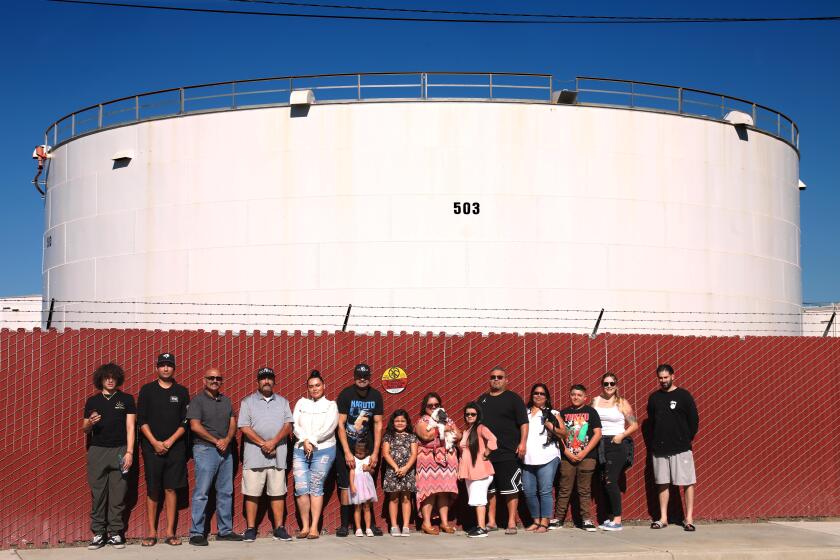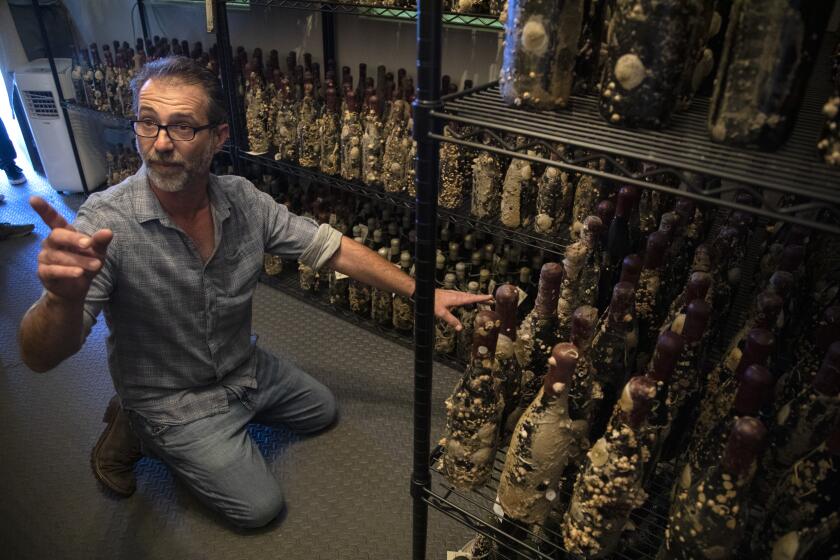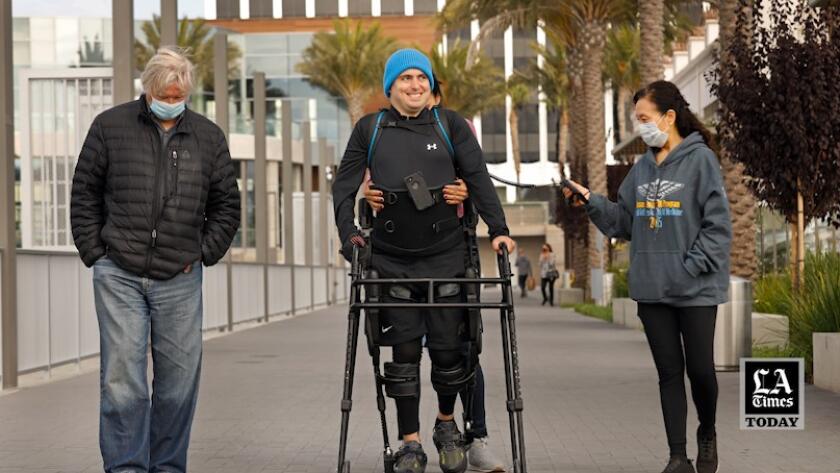Column: One step, then another. With determination and new therapies, there’s hope for paralysis patients
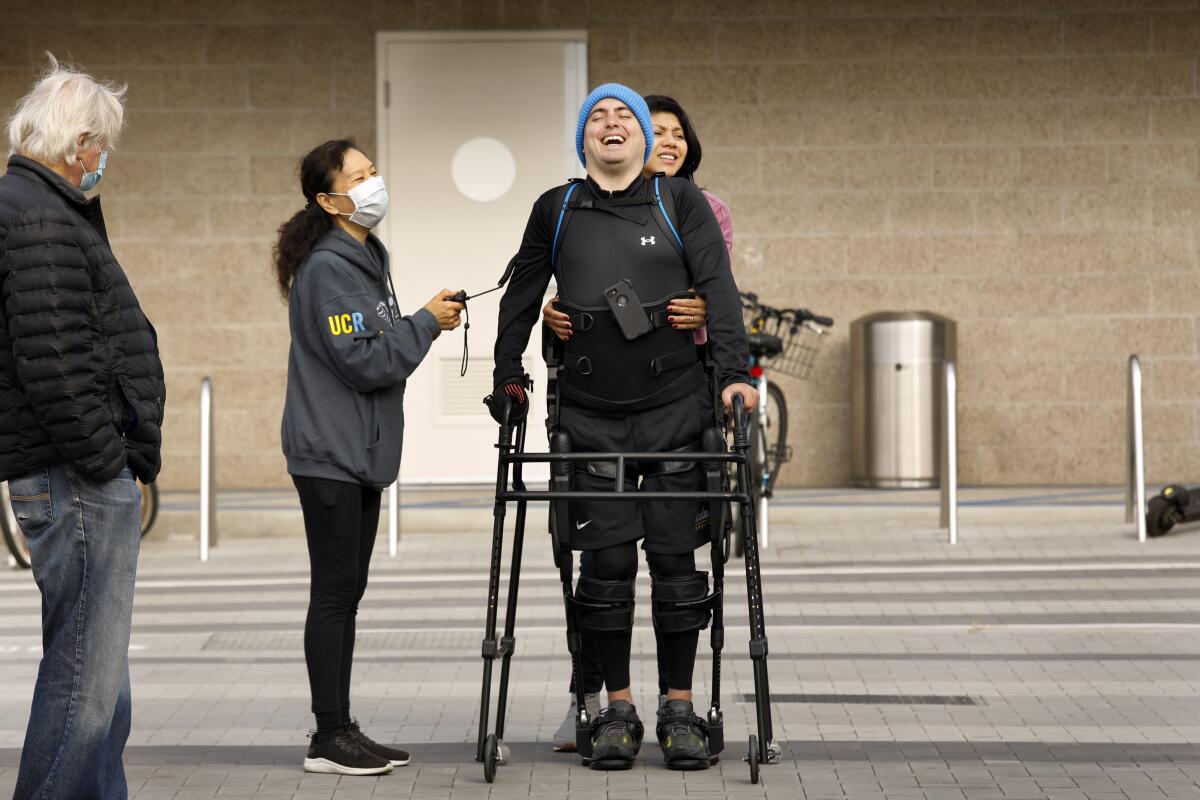
Ignacio Montoya pauses, gathers strength, takes a step.
Then another, and another.
With the assistance of a walker, an exoskeleton suit and robotic legs that are attached to his own and help propel him forward, Montoya is making his way up and down the promenade along the water’s edge at the Marina del Rey boat basin, next to the Trader Joe’s.
“Christopher Reeve would be amazed,” says UCLA scientist Reggie Edgerton, who worked with the late actor and is now watching Montoya’s every move.
Walking without assistance isn’t likely anytime soon, if ever, for those with severe spinal injuries. But some improvements in function, thought impossible until recent years, are now being realized.
Montoya was nearly killed in 2012 when a minivan crossed into his path while he was on his motorcycle. At the time, Montoya was studying simultaneously at Georgia State University and Georgia Tech — as well as working at a bank and training in the Air Force ROTC program.
In the violent collision, nerves in Montoya’s neck were shredded. His lungs collapsed. His back was broken. A spinal cord injury left him paralyzed in one arm and both legs. Montoya, who turned 22 the day before his injury and is now 30, was told he had maybe a 1% chance of regaining any sensation.
But Montoya, whose family came to the United States from Cuba after winning a visa lottery when he was 6, is the kind of person who thinks one chance in a hundred is reason for optimism. He completed his business degree a year after the accident, followed by a master’s in biomedical engineering. He then set out to study the state of spinal cord injury treatments around the world, determined to prove his prognosis wrong.
That led him in the summer of 2019 to the UCLA lab of Edgerton, a man whose own relentless determination made for a good fit with Montoya. Edgerton had polio as a young lad in North Carolina but played baseball and basketball. He says he wanted to be seen as just another kid, and treated equally.
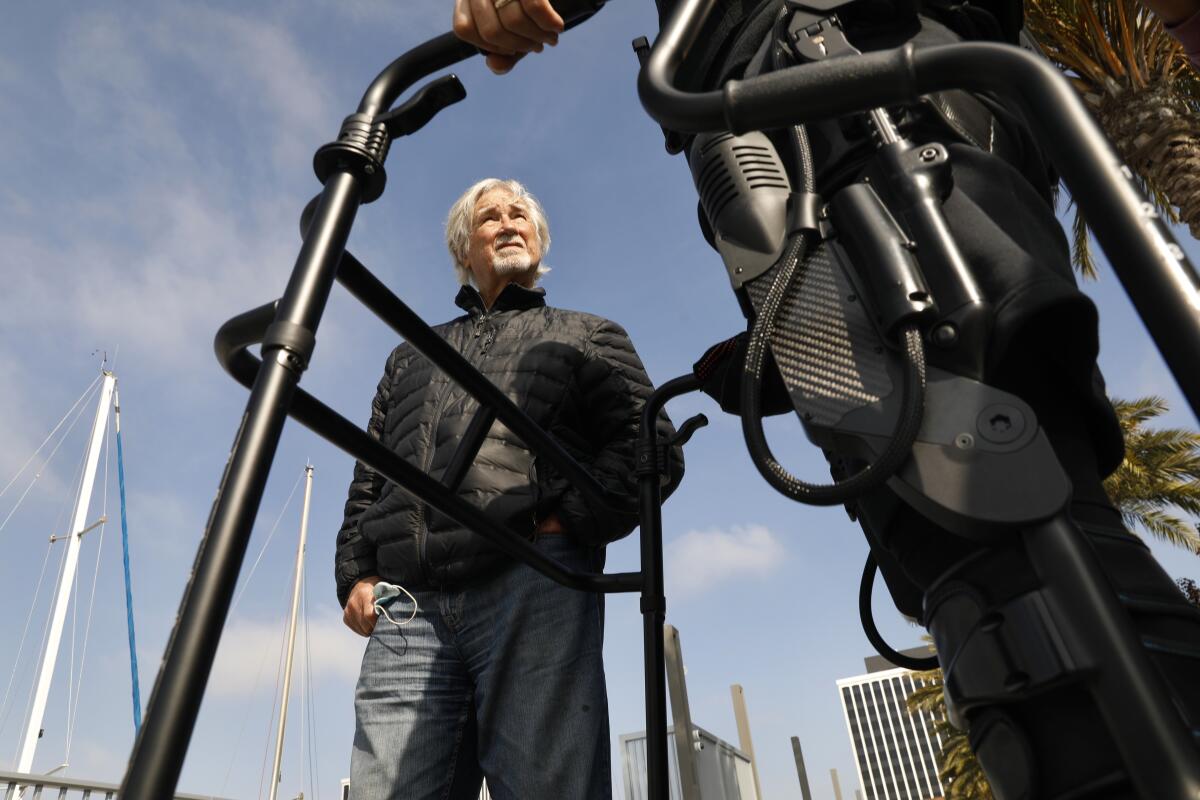
“I’m 81 years old,” Edgerton tells me while watching Montoya move along the promenade. Edgerton is finally seeing the benefits of painstaking research he and a handful of other scientists in the world have been grinding away on, trying to push the boundaries of possibility.
Working with funding made possible in part by the activist efforts of Reeve — who was paralyzed after a fall from a horse in 1995 and died in 2004 — Edgerton has explored the ways in which the brain and spinal cord can be retrained to work together. With gradual refinements, especially in the last few years, he says he has seen patients stand and move with assistance, regain sensation in lower extremities, and improve bladder control and sexual activity.
“It smells like dead people,” says one Carson resident of the stench that has plagued the area for weeks. But environmental hazards of all types are common in the community.
“I’ve just started the same thing with cerebral palsy kids, and I don’t want to overstate it, but what we’re seeing … frankly is phenomenal,” Edgerton says.
Earlier in his career, Edgerton had no shortage of skeptics in medicine, and some even scoffed at his theories.
“He’s always been a bit countercultural,” says Dr. Richard L. Lieber, chief scientific officer of the Shirley Ryan AbilityLab in Chicago. “Basically, he got Christopher Reeve up and walking and that really shook the place.”
Edgerton’s therapy “isn’t the answer for everyone,” says Lieber, who noted ongoing research by other scientists. But the AbilityLab honored Edgerton in 2019 for what Lieber called “his monumental impact in the fields of neuromuscular physiology and rehabilitation.”
He says Edgerton “spawned an entire cottage industry of rehabilitation and I would say it’s one of the most promising treatments for spinal cord injury in our time.”
Dr. Charles Tator, a neurosurgeon and researcher in Toronto, says he tried similar therapies a few decades ago but didn’t have much success. He now thinks Edgerton has had breakthroughs that might one day lead to similar treatment not just for cerebral palsy patients, but for stroke patients as well.
“Reggie is trying to wake up the damaged nervous system and do things that are not possible without new tricks,” says Tator. “In my view, he’s a real pioneer.”
But that required as much patience as perseverance.
About 10 years ago, after years of research on mammals proved promising, Edgerton employed a procedure in which electrodes were surgically implanted over the spinal cord to stimulate the central nervous system. Even with severe damage to a spinal cord, he says, some neurological pathways remain in place.
In recent years, he switched to a simplified and less invasive form of the same concept, attaching electrodes to the skin over the lumbar portion of the spine.
“We’ve gotten probably half of our subjects who were completely injured to be able to stand within a matter of four to eight weeks of training,” says Edgerton, who doesn’t yet know the full potential, nor the limitations, of such treatments. The state of spinal cord therapy, he says, is at about the same stage where the Wright brothers were when they first flew a plane.
*
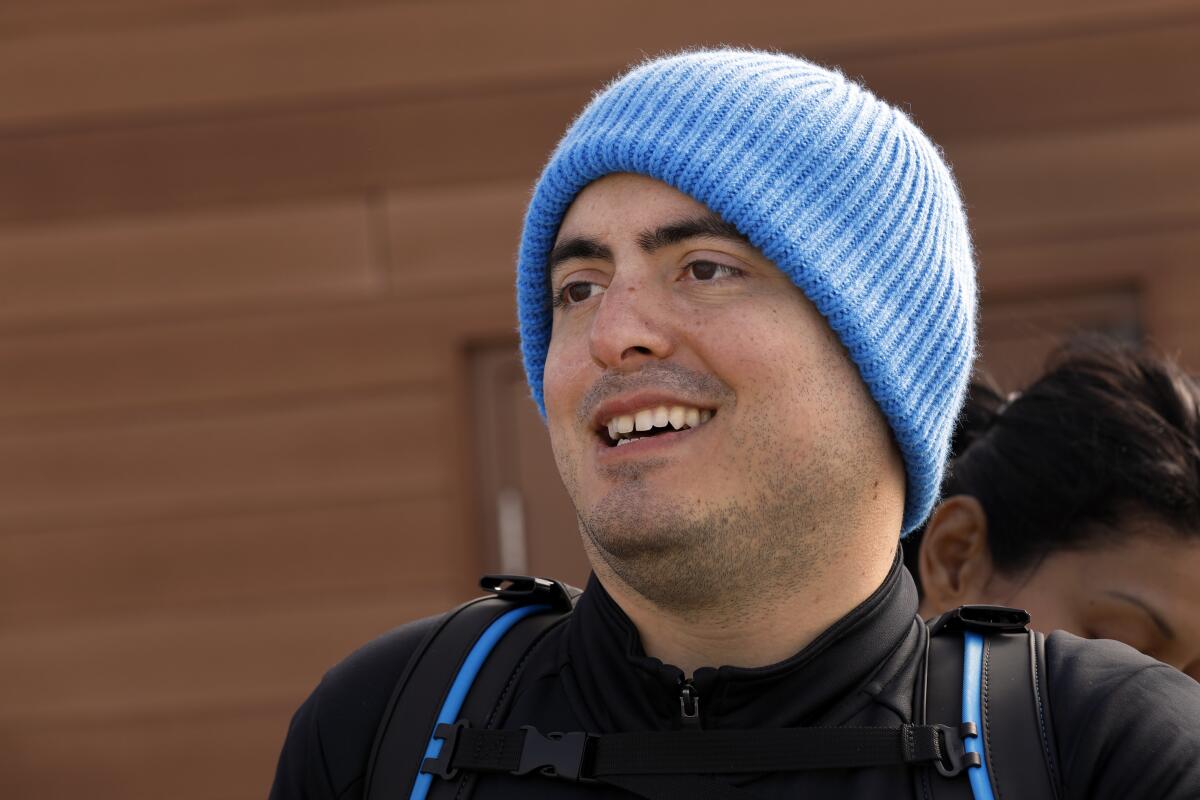
Montoya remembers his flight out of Cuba as a child. Though he was just 6, he recalls a sense of liberation, as well as the beginnings of his desire to become an aviator and serve his adopted country. During his college years and ROTC training, his goal was to become an F-16 fighter pilot. Then came the accident.
“I was pronounced dead,” says Montoya, who tells me he was revived in the emergency room. “After you have a spinal cord injury, you get sent home in a wheelchair. It doesn’t matter where you are in the United States or the world. They may give you inpatient therapy for a month, two months, three if you’re lucky. And you might get a little outpatient therapy if you’re lucky.”
But you don’t get sent home with much hope.
“Clinicians feel obligated to tell them they’re never going to walk again,” Edgerton says. “This is one of the first things they hear.”
The prevailing consensus, Edgerton says, has been that a year after suffering a severe spinal cord injury, even minimal recovery is highly unlikely if not impossible.
“It’s almost impossible to get insurance to cover any type of treatment,” Edgerton says.
He understands the danger of creating false hope in patients, but also the danger of giving no hope at all, especially as the number of medical tools grows, as does the bank of knowledge about how the nervous system controls movement.
He now has three other patients going through the same treatment regimen as Montoya, who works out at the marina three days a week and two more days a week in Edgerton’s UCLA lab.
At the lab, Montoya is suspended weightlessly over a treadmill with electrodes attached to his spine to stimulate his nervous system.
“My brain is interpreting these sensations,” Montoya says, and with assistance from therapists, he is able to contract muscles and move his legs, even after the electrical stimulation is removed.
He then lies on his side, suspended again, and is able to voluntarily contract muscles to move his legs, as if he’s pedaling a bike.
The sensations he feels are nothing like what he felt before the accident, Montoya says. But the electrical stimulation — and a growing awareness of communication between his brain, spinal circuitry and muscles — is making movement possible. It’s as if he’s learning to eavesdrop on a conversation between his brain and nervous system, and using that intelligence to begin learning how to regain some control.
“You can’t be passive,” Montoya says. “You have to think really, really hard about every little muscle and every little movement, and when you concentrate, you’re able to tap into those peripheral nerves. And that’s when you can contract muscles.”
Edgerton says that in the case of bladder control, the spinal cord injury patient “knows the bladder needs emptying even though the signal feels different.”

Montoya says he has been able to contract muscles in his lower extremities and abdomen, which helps with his breathing. He says exercise has produced an overall feeling of greater physiological function. It also seems to relieve chronic severe arm pain, and his bone density has reached normal levels.
“I’ve been able to accelerate my heart rate, which in turn increases my circulation, and I’m able to get rid of neuropathic pain,” Montoya says. “I’m able to regulate my body temperature, I’m sweating for the first time when working out, and I’m actually feeling hungry and thirsty again.
“I mean, it’s revolutionary, it’s life changing, and I am seeing it and I am witnessing it. And for someone who has been paralyzed … the last eight years, almost nine, I am feeling sensation. And for me to say those words is incredible.”
Coastal regulators said no to sunken vino, but Santa Barbara winemakers raise glass to second chance
Equally incredible is how much energy Montoya has. Despite the demands of his time-consuming therapy sessions, he is also attending Cal State University Los Angeles in pursuit of yet another master’s degree, this one in kinesiology, so he’s better able to understand his own recovery and give him an edge with a company he works for as chief scientific officer.
HINRI, the Healthcare Institute for Neuro Recovery and Innovation, is a nonprofit whose mission is to study medical breakthroughs — particularly in paralysis therapy — and build support for researchers, giving them the resources necessary to accelerate new therapies.
“The more I put on my schedule, and the busier I am, the better I perform,” Montoya says.
Montoya, like Edgerton, doesn’t know what further recovery he’s capable of. It’s too soon to know, and promise is tempered by reality. There is no cure for severe spinal cord injuries, Montoya says. But there are interventions, such as the ones he’s undergoing, that can help treat “the mental paralysis” as well as the physical. “The mental paralysis of not seeing any hope.”
When it comes to flight, Montoya now has a variation on his original dream. With space travel expanding in recent times, he’s raising his hand for a seat on the next launch, hoping for a chance to be what he calls “an accessibility ambassador” to those with disabilities.
Montoya says he’s grateful for Edgerton’s inspiration, and for the chance to help “continue the legacy of Christopher Reeve.” And he’s enjoying life in California.
At the water’s edge, curious onlookers study Montoya, who tells the short version of his life story to those who ask. He gets a thumbs up and a “good luck” as he takes one step, then another, then another.
“I told Reggie I’m not leaving here unless it’s on my feet, walking,” Montoya says.
Watch L.A. Times Today at 7 p.m. on Spectrum News 1 on Channel 1 or live stream on the Spectrum News App. Palos Verdes Peninsula and Orange County viewers can watch on Cox Systems on channel 99.
More to Read
Sign up for Essential California
The most important California stories and recommendations in your inbox every morning.
You may occasionally receive promotional content from the Los Angeles Times.


